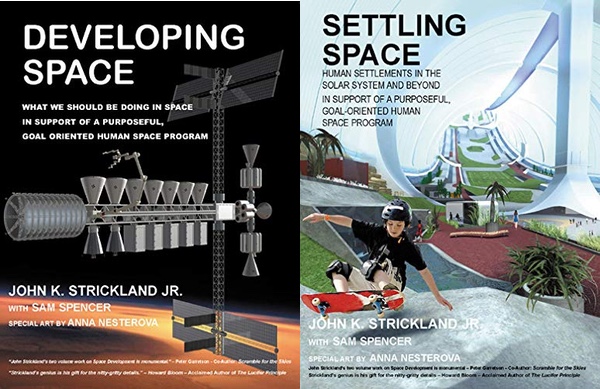Review: Developing Space and Settling Spaceby Jeff Foust
|
| Strickland explores issues as varied as the economics of reusable launch vehicles, chemical processes for in situ resource utilization, and construction methods for space settlements in the books. |
The first volume, Developing Space, is a more near-term analysis of exploring and living in space. Strickland starts with space transportation, including SpaceX’s Falcon and Starship systems but also alternative vehicles and concepts, and builds out from there. He analyzes in detail development of facilities both on the Moon and in cislunar space, as well as architectures for getting to Mars and establishing a settlement there.
The second volume, Settling Space, is a little more speculative. He picks up where he left off in the first volume, exploring how to establish a larger Mars settlement, like what Musk envisions. The book, then goes on to examine asteroid mining, free-space settlements (aka space colonies), and even terraforming and interstellar travel.
The defining aspect of the two books is the scope and attention to detail. Strickland explores issues as varied as the economics of reusable launch vehicles, chemical processes for in situ resource utilization, and construction methods for space settlements in the books. For example, when discussing the development of outposts in cislunar space, he devotes several pages to how to build a truss that would serve as the backbone of it, from socket-in-tube construction techniques to the use of robots to assemble it.
That level of detail, and how it is presented, can be dizzying at times: portions of the books are filled with tables and equations, and large blocks of text alternate with long bulleted lists. He uses this approach to demonstrate that the approaches he outlines in the book, be they bases on the Moon or terraforming Mars, at the very least do not violate physical laws (even if they require, in the case of obtaining the nitrogen needed for terraforming Mars, mining ice from Pluto.)
Strickland does not ignore the question of why humans should explore and settle space, but it is not a major focus of the books. Early sections of Developing Space examine the “dysfunctional” space policy of past decades while the opening pages of Settling Space critique arguments against settling Mars. But the sections seem intended more to assuage any lingering doubts a reader might have about the importance of human space exploration and settlement, rather than a thorough argument in favor of it, as he moves on to focus on technical details.
So who, then, is the audience for these two books? It’s not for those skeptical of whether humans should live and work beyond Earth, but instead, perhaps, for those skeptical of whether it is technically feasible. (Whether it makes economic sense, in terms of costs and profitability, is a topic also not largely addressed in the books.) Strickland, at the very least, offers considerable detail about how Moon and Mars settlements, and more, could be achieved. But maybe Elon Musk has something else in mind, if he ever decides to share those details.
Note: we are using a new commenting system, which may require you to create a new account.
